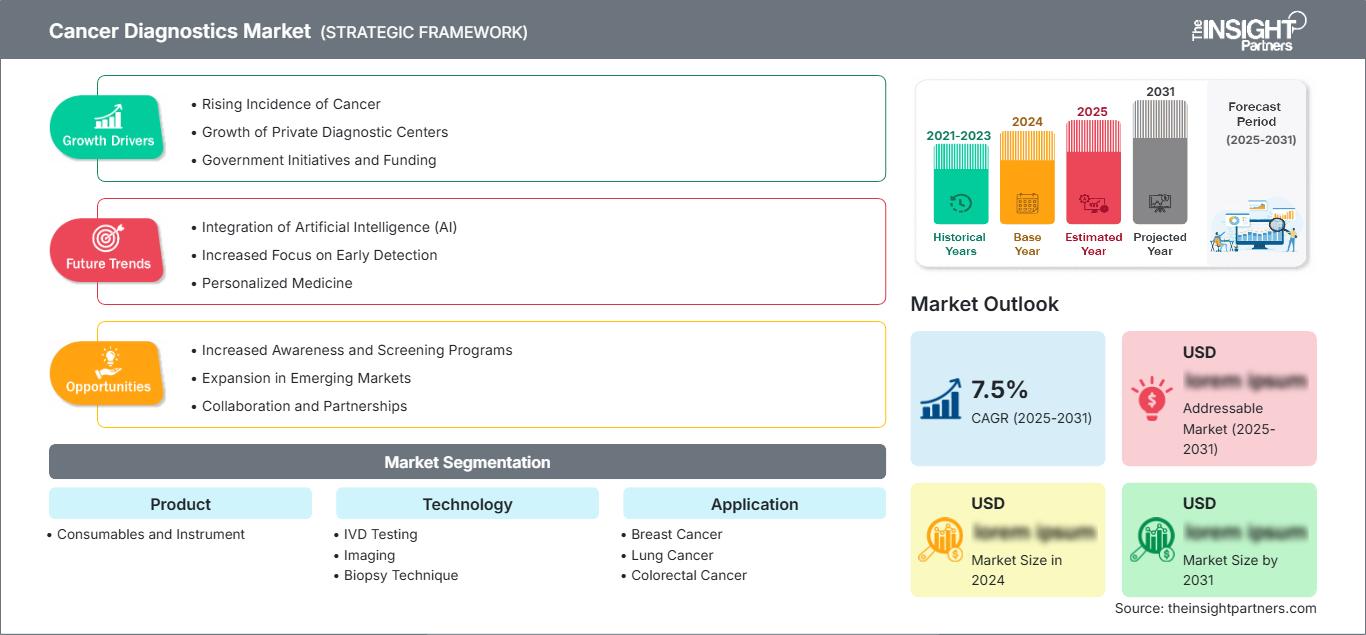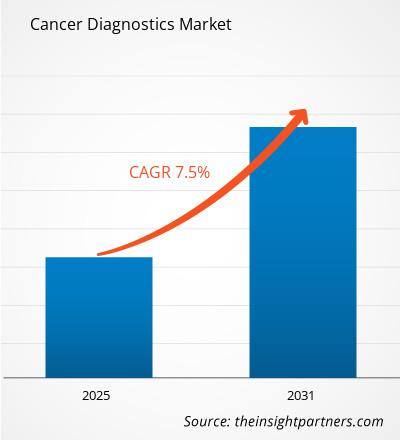页面已更新 :
Jan 2025
预计到2031年,癌症诊断市场规模将达到2562.2亿美元。预计该市场在2025年至2031年期间的复合年增长率将达到7.5%。
该报告按产品(耗材和仪器)、技术(体外诊断检测、成像和活检技术)、应用(乳腺癌、肺癌、结直肠癌、黑色素瘤和其他癌症)以及最终用户(医院和诊断实验室)进行细分。全球分析进一步细化到区域和主要国家层面。报告以美元为单位提供上述分析和细分市场的价值。
报告目的
The Insight Partners发布的《癌症诊断市场报告》旨在描述癌症诊断市场的现状和未来增长趋势,包括主要驱动因素、挑战和机遇。该报告将为各类商业利益相关者提供参考,例如:
- 技术提供商/制造商:了解不断变化的市场动态和潜在的增长机会,从而能够做出明智的战略决策。
- 投资者:对市场增长率、市场财务预测以及整个价值链中存在的机会进行全面的趋势分析。
- 监管机构:监管市场政策和执法活动,旨在最大限度地减少滥用行为,维护投资者信任和信心,维护市场的诚信和稳定。
癌症诊断市场细分产品
- 耗材和仪器
技术
- 体外诊断检测
- 成像
- 活检技术
应用
- 乳腺癌
- 肺癌
- 结直肠癌
- 黑色素瘤
- 其他癌症
最终用户
- 医院和诊断实验室
根据您的需求定制此报告
您可以免费获得任何报告的定制服务,包括本报告的部分内容、国家/地区层面的分析、Excel 数据包,以及面向初创企业和高校的优惠折扣。
癌症诊断市场:战略洞察

- 获取本报告的主要市场趋势。这份免费样品将包含数据分析,内容涵盖市场趋势、估算和预测等。
癌症诊断市场增长驱动因素
- 癌症发病率上升:全球多种癌症发病率的不断攀升是主要驱动因素。随着癌症发病率的增加,人们越来越重视采用先进的诊断机制来提高疾病的早期发现率和患者的治疗效果。因此,现代诊断系统的出现和应用势在必行。
- 私立诊断中心的发展:此外,诊断中心的进步也促进了市场的增长。这类机构往往提供更优质的服务和更先进的诊断设备,从而促进了癌症筛查的开展。
- 政府举措与资金:政府活动与支持:各国为癌症防控和早期筛查活动拨出专项资金,从而催生了诊断服务市场。由于这些举措旨在促进全民健康并最大限度地减少癌症对医疗卫生系统的影响,因此通常都采用了卫生系统方法。
癌症诊断市场未来趋势
- 人工智能(AI)的融合:人工智能在癌症诊断发展中的应用日益重要。创新的人工智能系统通过海量数据处理、放射影像处理以及辅助活检诊断,不断改进现有的诊断设备。这种趋势将提高癌症诊断的速度和准确性,从而造福患者并简化医院的工作流程。
- 更加重视早期检测:随着人们对癌症风险的认识不断提高,以及癌症筛查技术的进步,癌症早期检测的重要性日益凸显。这主要是因为早期检测能够提升医疗服务的质量;因此,筛查手段也更加全面,例如液体活检和高端影像检查等。这种趋势很可能会带动市场增长,因为越来越多的人愿意接受机会性筛查。
- 个性化医疗:目前,个性化医疗正成为一种显著的趋势,其诊断基于患者的个人信息,包括基因组和生物标志物分析。这使得药物治疗能够更加精准,从而提高疗效并减少副作用。随着对生物标志物认识的不断深入,对相应检测的需求也将日益增长,这将推动新型诊断疗法的出现。
癌症诊断市场机遇
- 意识提升与筛查项目:人们对早期癌症筛查必要性的认识和理解不断提高,是推动筛查项目发展的主要因素。随着越来越多的人开始采取预防措施,预计癌症诊断市场将蓬勃发展。此外,各卫生机构倡导定期筛查也进一步促进了市场增长。
- 新兴市场扩张:随着发展中国家医疗服务可及性的提高,癌症诊断市场迎来了新的机遇。需求增长主要归功于医疗服务覆盖范围的扩大和癌症筛查意识的提高。任何能够开发适合这些经济体的解决方案的企业都将拥有更广阔的增长前景。
- 合作与伙伴关系:诊断公司、制药公司和研究中心的参与能够提升整个合作体系的创新能力,并拓宽产品市场。联合开发机会,特别是基于数据解决方案和检测技术进步的联合开发机会,将有助于拓展产品线,并实现更精准的诊断。
癌症诊断市场区域洞察
The Insight Partners 的分析师对预测期内影响癌症诊断市场的区域趋势和因素进行了详尽的阐述。本节还探讨了北美、欧洲、亚太、中东和非洲以及南美和中美洲等地区的癌症诊断市场细分和地域分布。
癌症诊断市场报告范围
| 报告属性 | 细节 |
|---|---|
| 2024年市场规模 | XX亿美元 |
| 到2031年市场规模 | 2562.2亿美元 |
| 全球复合年增长率(2025-2031年) | 7.5% |
| 史料 | 2021-2023 |
| 预测期 | 2025-2031 |
| 涵盖部分 | 副产品
|
| 覆盖地区和国家 | 北美
|
| 市场领导者和主要公司简介 |
|
癌症诊断市场参与者密度:了解其对业务动态的影响
癌症诊断市场正快速增长,主要受终端用户需求不断增长的推动,而这又源于消费者偏好的转变、技术的进步以及消费者对产品益处的认知度不断提高。随着需求的增长,企业不断拓展产品和服务,持续创新以满足消费者需求,并把握新兴趋势,这些都进一步推动了市场增长。

- 获取癌症诊断市场主要参与者概览
主要卖点
- 全面覆盖:该报告全面分析了癌症诊断市场的产品、服务、类型和最终用户,提供了一个全面的市场概况。
- 专家分析:该报告是根据行业专家和分析师的深入理解编制的。
- 最新信息:该报告涵盖了最新的信息和数据趋势,确保了其与业务的相关性。
- 定制选项:本报告可根据客户的具体需求进行定制,并能恰当地适应业务战略。
因此,这份关于癌症诊断市场的研究报告有助于深入了解和解读行业现状及增长前景。尽管其中可能存在一些合理的担忧,但总体而言,这份报告的益处远大于其不足之处。
- 历史分析(2 年)、基准年、预测(7 年)及复合年增长率
- PEST和SWOT分析
- 市场规模、价值/数量 - 全球、区域、国家
- 行业和竞争格局
- Excel 数据集
近期报告
相关报告
客户评价
购买理由
- 明智的决策
- 了解市场动态
- 竞争分析
- 客户洞察
- 市场预测
- 风险规避
- 战略规划
- 投资论证
- 识别新兴市场
- 优化营销策略
- 提升运营效率
- 顺应监管趋势
我们的客户































87-673-9708

ISO 9001:2015



 获取免费样品 - 癌症诊断市场
获取免费样品 - 癌症诊断市场